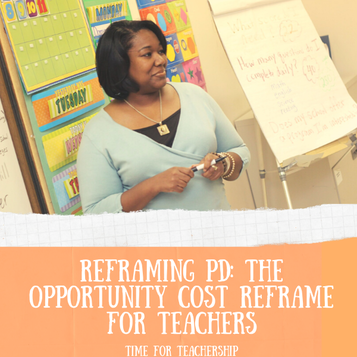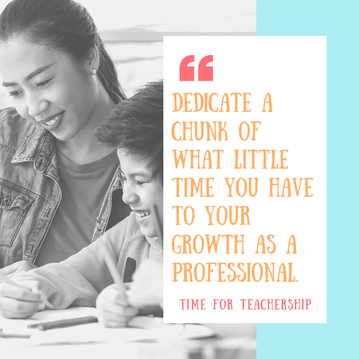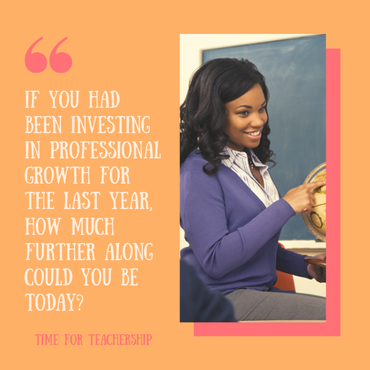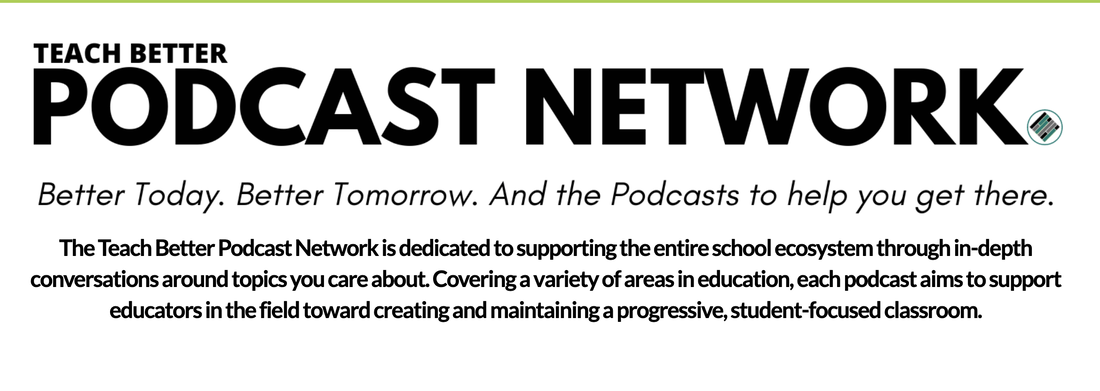|
Earlier this week, I shared another reframing PD post for leaders. While the essence is similar, this post is written specifically for teachers. I am a big proponent of dedicating a chunk of what little time we have as teachers to investing in our individual growth as professionals. When teachers hear me recommend they should spend more time on PD (remember, I’m using the term to mean your professional growth, not exclusively staff PDs), they usually say, “I don’t have time for that much PD.” While I hear you because I’ve been there, this post details the reframing that helped me embrace the idea of investing in my personal PD and ultimately improve my effectiveness as a teacher. To reiterate: my biggest growth spurts as a teacher came from taking the time to learn a new approach and try it out. Don’t underestimate the power of investing in your learning, even if (or maybe especially if) it seems like your time or energy is stretched too thin to take on one more thing! So, what are the most common reframes I use? Here, I’ll share the 2 most common responses I hear from teachers when presented with a PD opportunity. Then, I’ll share how you could use what I can an opportunity cost reframe. (An opportunity cost is essentially what we’re giving up, what else we could be doing with our time or energy.) Here’s one: The “I can’t take time from grading/lesson planning” response. I often hear teachers say: If I take time away from grading or planning this lesson to learn something new, my kids will suffer. Now, let’s apply an opportunity cost lens. So, how can we reframe that initial response? Try asking yourself these reframing questions: What if the professional development I spend time on teaches me how to plan efficiently and grade faster and it actually saves me time in the long run? What if it helps me build engaging learning activities so that students are on-task and excited to learn every day? What if it means I would be able to stop taking work home—the planning/grading work and the mental stress? Here’s another one: The “I can’t miss class for PD” response. When teachers are offered a chance to attend a school-day PD (like visiting another school or a curriculum planning day or a workshop off-site), I often hear teachers say: I can’t leave my kids; they’ll miss out on a day of learning. How might we reframe this? Try asking yourself these reframing questions: Would I sacrifice one day of student learning and the time it takes to prep sub plans (which is often harder than prepping your own lessons) if it meant me and my students would be energized and engaged for the rest of the year? What if it just increased engagement for semester? One unit? What if the thing I could accomplish by missing ONE day of class could drastically improve student engagement and achievement? This is truly a mindset game. If you take time to invest in PD opportunities, students may miss a whole day of learning from having a sub. They may miss out on you grading a few homework assignments. I don’t have a magic wand to wave to give you more time to invest in your professional growth while also preserving your grading and planning time. You have got to decide how to best use the limited time you’ve got. So, the question I want you to start asking is: Am I willing to risk the opportunity cost of not investing in my professional growth? If you skip out on opportunities to learn how to be a more engaging, effective teacher, students could miss out on deeper, more engaged learning opportunities. I know we all want our students to be engaged and learning as much as possible. We may just need to reframe our thinking about how to reach this goal. Just think: If you had this mindset towards investing in your professional growth one year ago, how much further along could you and your students be today? I can point to specific PD experiences that, had I not had them, I would have been significantly less effective as a teacher, had less fun in my job, and as a result, probably would have quit teaching after year 3. Instead, I used that time to learn new things, but also to stop and see the big picture, realize there were alternatives to the way I’d always done things, and choose to make a strategic shift. I grew my practice year after year, becoming not only more effective and energized, but courageous enough to set a goal to bring zero work home. (Spoiler alert: I hit that goal!) Without looking at PD through an opportunity cost lens, I would NEVER have been brave enough to set such a goal, let alone achieve it. To help you apply an opportunity cost reframe, I made a worksheet for you that gives you more specific questions regarding the opportunity costs of a particular PD opportunity as well as space to process your thoughts in writing.
0 Comments
Leave a Reply. |
Details
For transcripts of episodes (and the option to search for terms in transcripts), click here!
Time for Teachership is now a proud member of the...AuthorLindsay Lyons (she/her) is an educational justice coach who works with teachers and school leaders to inspire educational innovation for racial and gender justice, design curricula grounded in student voice, and build capacity for shared leadership. Lindsay taught in NYC public schools, holds a PhD in Leadership and Change, and is the founder of the educational blog and podcast, Time for Teachership. Archives
May 2024
Categories |





 RSS Feed
RSS Feed